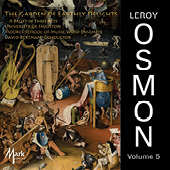
 |
| The Music of Leroy Osmon, Vol. 5: The Garden of Earthly Delights |
| Group Name |
University of Houston - Moores School of Music Wind Ensemble |
| Conductor |
David Bertman |
|
Album ID - 51965-MCD |
|
| ALBUM NOTES |
1. Introduction: The Third Day of Creation
Act I: The Garden of Eden
2. Scene 1: The Creation of Adam and Eve
3. Scene 2: The Black Serpent Curls
4. Scene 3: The Predatory Beast
5. Scene 4: Eden, On the Eve of Passing
Act II: The Garden of Earthly Delights
6. Scene 1: In the Days of Noah
7. Scene 2: Young Maidens Embrace Lust and Eroticism
8. Scene 3: Dance of the Lustful Inhabitants
9. Scene 4: The Violation of Innocence
10. Interlude
Act III: Hell
11. Scene 1: Dance of the Perverted Love and Lust
12. Scene 2: Eternal Dance of Death
13. Scene 3: Dance of Vanity
14. Scene 4: The Dreamer of Hallucinating Nightmares
The ballet consists of an “Introduction,†three “Acts†(each having four “Scenesâ€) and an “Interlude†before “Act III.†The scenario is from the Hieronymus
Bosch 1504 painting which came to be known as “The Garden of Earthly Delights.†The ballet is dedicated to Capt. Cesar Amora Aguilar (conductor for
the world première performance in Xalapa, Veracruz, Mexico). The titles for each Act and Scene are taken directly from specific sections of the Bosch
painting. The inspiration for the individual sections came from the painting as a whole as well as from the smallest of images within the painting. The
various styles found within the music are directly related to the images on the canvas: from the harsh to the sublime; from the abstract to the realistic.
Composer Leroy Osmon lived and worked in the Mexican state of Veracruz for several years.
The music is a graphic representation of the Bosch painting and follows the same biblical narrative. Act I represents the “left†panel and depicts the
presentation of Eve to Adam, the Serpent, and the passing of Eden. Act II presents Noah (represented by the continuous playing of a two-note motif),
lust, eroticism and the violation of innocence, complete with a cast of nude characters and fantastical animals. Act III, the right panel, has been
described by art historians as a “hells cape and portrays the torments of damnation†via a dance.
Leroy Osmon is an internationally-known composer who is presently lives in Merida, Yucatan, Mexico. The music of Leroy Osmon has been performed
throughout the United States as well as in Europe, Australia, Japan, Israel, India and Mexico. In 2004, Osmon received two Grammy Entry List
Appearances (“Best Classical Performance†by a small ensemble and “Best Classical Albumâ€), and in 2008 “The Music of Leroy Osmon, Vol. IV†received a
Grammy Entry List Appearance for “Best Classical Album.â€
He has been a consultant to the Governor and the Institute of Culture for the State of Yucatan and was instrumental in the creation of the Yucatan
Symphony Orchestra (Orquesta Sinfonica De Yucatan). For 14 years, Osmon worked as an advisor to the Orquesta de Camara at the University of Yucatan
(UADY). In January 2008, Leroy Osmon’s composition “Zeraim from The Book of Ruth†was nominated for both a Pulitzer Prize for Chamber Music and
the University of Louisville Grawemeyer Award for Music Composition. Leroy Osmon’s teachers have been Charles A. Wiley, Paul Holmes, Richard Kole
and Fisher Tull. |
|
|

